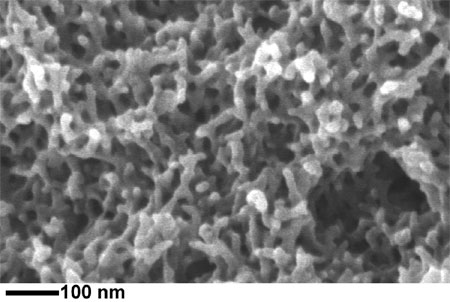12/14/2007
Tough Nanoporous Membranes with a 3-D pore structure
Recent research from the group of Professor Marc
Hillmyer.
Controlled
fabrication of nanoporous polymer membranes has attracted growing interest
due to their applicability as catalyst supports, ultrafiltation membranes,
or templates for the synthesis of other nanomaterials. It has been generally
shown that self-assembled block copolymers comprising a non-degradable
block (matrix) such as polystyrene (PS) and a chemically-etchable block
such as polylactide (PLA) can be used to generate nanoporous materials
upon removal of the sacrificial component. However, in most cases the nanoporous
materials made by this route suffer from poor mechanical performance and
limited chemical and thermal stability. While crosslinking the matrix material
has shown promise in improving the thermal properties, the lack of toughness
in these materials is still a significant issue.
Targeting novel nanoporous
polymer membranes that are chemically, thermally and mechanically robust,
graduate student Liang Chen working with Professor Marc Hillmyer integrated
polydicyclopentadiene (polyDCPD), a strong thermosetting material prepared
by Ring-Opening Metathesis Polymerization (ROMP), and PLA into thin polymeric
films. By incorporating a "doubly" reactive block copolymer containing
etchable PLA and ROMP-reactive PNS (see chemical structures below) during
the ROMP of DCPD using Grubbs catalyst, Liang prepared a nanoscopically
organized composite film. Removal of the PLA by treatment with aqueous
base yielded a nanoporous membrane (average pore diameter of 17 nm) with
a high porosity (40%), a large specific surface area (160 m2 g–1),
and narrow pore size distribution. The resulting mesoporous polyDCPD composite
membranes were thermally stable up to 140 °C, and exhibited remarkable
toughness comparable to the parent polyDCPD. The three dimensionally continuous
pore structure was confirmed by a combination of scanning electron microscopy
(see image below), ionic conductivity and gas diffusion measurements. Potential
applications of these novel membranes as high surface area catalyst supports,
size selective membranes, and nanomaterial templates are currently being
explored. This work was recently been published in the Journal
of the American Chemical Society (volume
129, pages 13786–13787).


|